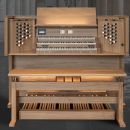Dudelange St.Martin
The organ in St. Martin’s church was built in 1912 by the organbuilder Georg Stahlhuth (1830-1913) and his son Eduard Stahlhuth (1862-1916). As Germans, installed at Aachen, Georg and Eduard Stahlhuth had all the basic knowledge of German romantic organbuilding. As disciples and close friends of Joseph Merklin at Brussels and Lyon, they had a share in the development of French symphonic organbuilding. Their contracts in England and Ireland provided them with good knowledge of English romantic organbuilding. Thus, they were among the rare organbuilders able to incorporate both French and English characteristics into German romantic organbuilding, defending in this way Albert Schweitzer’s ideas in matter of organbuilding, ideas on which the project founded in 1912.
An organ with character
The three-manual organ of 1912 had 45 stops (and 3 transmissions under expression in the pedal) on cone-valve chests with pneumatic note and stop action. Wind was supplied by three English water engines. A further borrowing from English organbuilding was the high-pressure Tuba mirabilis 8‘ in the Positiv-Swell division, voiced on 300 mm. Typical French faetures were the overblowing stops (typical of Stahlhuth’s organs) and the reeds of French-style construction (with tin-plated shallots), of which at least three were supplied by the Paris firm Veuve Jules Sézerie: Vox humana 8', Tuba 8' and Posaune 16' (octave grave de bombarde 16', grosse taille).

Dudelange St.Martin
Specifications
General
- Stahlhuth, 1912
- 4 manuals
- 72 stops



































